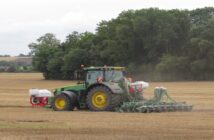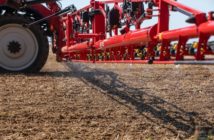Careful monitoring of oilseed rape for pollen beetle, with spraying only if necessary, is the key to sustainable and cost-effective control advises Dr Paul Fogg of Adama.
“Crops are only vulnerable to pollen beetle damage at the green-to-yellow bud stage,” says Dr Fogg, “and if the level of pollen beetle is below the treatment threshold at this stage there is no need to spray. Unnecessary spraying increases selection pressure and ultimately the resistance status of a given population.”
Field conditions
However, field and plant conditions must also be taken into account, says Oxfordshire based independent NIAB TAG agronomist Jon Bellamy.
“Threshold advice suggests that crops with a low population have a greater capacity to compensate for lost buds and flowers, but this won’t be the case if the population is low due to poor soil, slug or pigeon damage. You are looking at a range of 500 to 750 pollen beetles per square metre, so would want well established, hybrid plants growing well to be really confident not to spray.
“Cool weather also leaves the plant in bud and ‘at risk’ for longer and prevents pollen beetles (unable to fly at temperatures below 9°C) from flying away.
All these are factors to bear in mind when considering if and when to spray.”
Resistance monitoring
Monitoring carried out by the Insecticide Resistance Action Committee (IRAC), and also independently by Adama across Europe has shown high levels of pyrethroid resistance. In monitoring by Adama, 27 pollen beetle populations treated with the pyrethroid lambda-cyhalothrin showed resistance.
• In 15 of the populations, between 10-50% of beetles survived a full field rate treatment.
In the same trials, treatment with tau-fluvalinate, a pyrethroid but with subtle difference to its chemical structure gave outstanding results:
• Complete kill in 19 of the populations
• Over 90% control in all but one of the remaining populations.
“Tau-fluvalinate is a pyrethroid, with a different mode of action and a narrow target spectrum that still has excellent activity in the field, yet is significantly more cost-effective than non pyrethroid options,” says Mr Bellamy. “Being bee friendly it is particularly useful when part of the field is backward and needs treating for pollen beetle and the good end of the field is partly in flower. You can also tank mix it with a triazole, which gives added flexibility.”
For more information Click Here
Pollen beetle: sustainable control
• Monitor crops once a week during the ‘at risk’ green-to-yellow bud stage
• Don’t spray unless treatment thresholds are exceeded
• Don’t spray as ‘insurance’ – this will increase resistance pressure
• Don’t spray once the crop has flowered – pollen beetles are attracted to open flowers and become pollinators
• Consider alternatives to pyrethroids or pyrethroids with a different mode of action, e.g. tau-fluvalinate
• Apply no more than one chemical group to a crop per season



